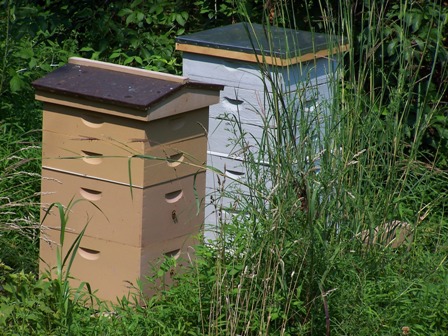[Note from Nan: Our newest guest contributor, Catherine Renzi, is owner of Yellow Springs Farm Native Plants Nursery in Chester Springs, Pennsylvania. Her posts will focus on the importance of native plants for habitat, biodiversity, and sustainability, as well as their great colors, textures, and the aesthetics. You can find out more about her and the nursery by visiting the Yellow Springs Farm website.]
 Like other animals, honey bees require adequate shelter and food in order to survive. Honey bees (Apis mellifera) are not a native species, but were brought to America by European colonists. It is especially interesting to see how this “Old World” species selects among native plants (“New World” species) and naturalized European and Asian species to fill its needs.
Like other animals, honey bees require adequate shelter and food in order to survive. Honey bees (Apis mellifera) are not a native species, but were brought to America by European colonists. It is especially interesting to see how this “Old World” species selects among native plants (“New World” species) and naturalized European and Asian species to fill its needs.
Food for honey bees is made up of water, nectar, and pollens. Water is as essential to honey bees as it is to us, for the same reasons. Nectar provides a good deal of water and sugar. The sugar can be used immediately by the bees for energy or brood rearing, or stored as honey for later consumption when sugar is needed and nectar is no longer available in winter.
When the temperature reaches about 45 degrees F, honeybees are out looking for nectar (sugar) and pollen (protein). Pollens make up the nutritionally most important food in the hive. They provide the proteins, lipids, vitamins, minerals and micronutrients that support adult bee physiological equilibrium and brood development.
 When we watch the honeybees working in early Spring, we see they are attracted to non- native flowers such as Crocus and Winter Aconite (Eranthis hyemalis). But, they are also eager to find Pussy Willow (Salix discolor) and Silver Maple (Acer saccharinum) in flower. The bees return to the hive and dance to tell the others where to find the day’s harvest. Unlike butterflies, honeybees visit only one species per flight. They do not snack or browse, for example, from Crocus to Willow, to Maple, and back again. These patterns and preferences are fascinating parts of enjoying biodiversity in the garden.
When we watch the honeybees working in early Spring, we see they are attracted to non- native flowers such as Crocus and Winter Aconite (Eranthis hyemalis). But, they are also eager to find Pussy Willow (Salix discolor) and Silver Maple (Acer saccharinum) in flower. The bees return to the hive and dance to tell the others where to find the day’s harvest. Unlike butterflies, honeybees visit only one species per flight. They do not snack or browse, for example, from Crocus to Willow, to Maple, and back again. These patterns and preferences are fascinating parts of enjoying biodiversity in the garden.
